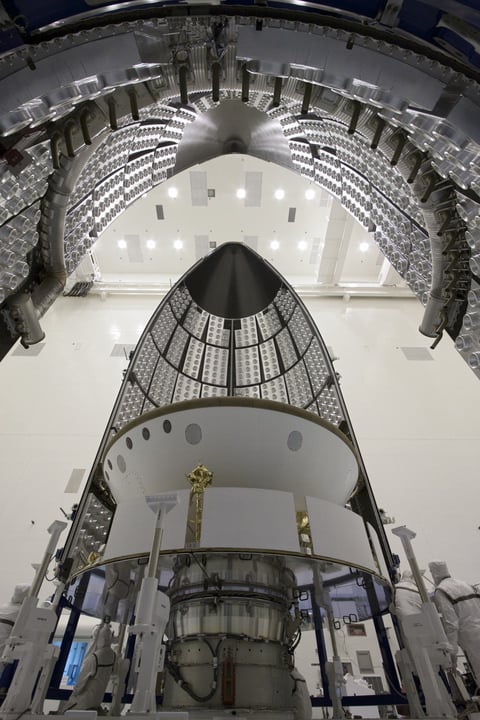[/caption]
Curiosity's
clamshell has been closed.
And it won't open up again until a few minutes after she blasts off for
the Red Planet
in just a little more than 3 weeks from now on Nov. 25, 2011 - the day after Thanksgiving celebrations in America.
The two halves of the payload fairing serve to protect NASA's next Mars rover during the thunderous ascent through Earth's atmosphere atop the powerful Atlas V booster rocket that will propel her on a fantastic voyage of hundreds of millions of miles through interplanetary space.
Spacecraft technicians working inside the Payload Hazardous Servicing Facility at NASA's Kennedy Space Center (KSC) in Florida have now
sealed Curiosity
and her aeroshell inside the payload fairing shroud. The fairing insulates the car sized robot from the intense impact of aerodynamic pressure and heating during ascent. At just the right moment it will peal open and be jettisoned like excess baggage after the rocket punches through the discernable atmosphere.
[caption id="attachment_90456" align="aligncenter" width="580" caption="Clamshell-like payload fairing about to be closed around Curiosity at KSC. Credit: NASA/Jim Grossmann"]
[/caption]
The next trip Curiosity takes will be a few miles to the Launch Pad at Space Launch Complex 41 at adjacent Cape Canaveral Air Force Station. She will be gingerly loaded onto a truck for a sojourn in the dead of night.
[caption id="attachment_90459" align="alignleft" width="386" caption="Curiosity in front of one payload fairing shell. Credit: NASA/Jim Grossmann"]
[/caption] "Curiosity will be placed onto the payload transporter on Tuesday and goes to Complex 41 on Wednesday, Nov. 2," KSC spokesman George Diller told Universe Today. "The logo was applied to the fairing this weekend."
At Pad 41, the payload will then be hoisted atop the United Launch Alliance Atlas V rocket and be bolted to the Centaur upper stage.
Installation of Curiosity's MMRTG (Multi-Mission Radioisotope Thermoelectric Generator) power source is one of the very last jobs and occurs at the pad just in the very final days before liftoff for Mars.
The MMRTG will be installed through a small porthole in the payload fairing and the aeroshell (see photo below).
[caption id="attachment_90460" align="aligncenter" width="580" caption="MMRTG power source will be installed on Curiosity through the porthole at right just days before Nov. 25 launch. Credit: NASA/Jim Grossmann"]
[/caption]
The plutonium dioxide based power source has more than 40 years of heritage in interplanetary exploration and will significantly enhance the driving range, scientific capability and working lifetime of the six wheeled rover compared to the solar powered rovers Spirit and Opportunity.
After a 10 month voyage, Curiosity is due to land at Gale Crater in August 2012 using the revolutionary sky crane powered descent vehicle for the first time on Mars.
[caption id="attachment_90461" align="aligncenter" width="580" caption="Camera captures one last look at Curiosity before an Atlas V rocket payload fairing is secured around it. Credit: NASA/Jim Grossmann"]
[/caption]
Curiosity has 10 science instruments to search for evidence about whether Mars has had environments favorable for microbial life, including chemical ingredients for life. The unique rover will use a laser to look inside rocks and release the gasses so that its spectrometer can analyze and send the data back to Earth.
[caption id="attachment_90458" align="aligncenter" width="386" caption="Technicians monitor Curiosity about to be engulfed by the two halves of the payload fairing. Credit: NASA/Jim Grossmann"]
[/caption]
[caption id="attachment_90457" align="aligncenter" width="386" caption="Payload fairing sealed around Curiosity at the Payload Hazardous Servicing Facility at KSC. Credit: NASA/Jim Grossmann"]
[/caption]
[caption id="attachment_90462" align="aligncenter" width="386" caption="Atlas V rocket at Launch Complex 41 at Cape Canaveral, Florida An Atlas V rocket similar to this one utilized in August 2011 for NASA's Juno Jupiter Orbiter will blast Curiosity to Mars on Nov. 25, 2011 from Florida. Credit: Ken Kremer "]
[/caption]
Phobos-Grunt
, Earth's other mission to Mars courtesy of Russia is due to blast off first from the Baikonur Cosmodrome on November 9, 2011.
Read Ken's continuing features about Curiosity starting here:
Curiosity Buttoned Up for Martian Voyage in Search of Life's Ingredients
Assembling Curiosity's Rocket to Mars
Encapsulating Curiosity for Martian Flight Test
Dramatic New NASA Animation Depicts Next Mars Rover in Action
Read Ken's continuing features about Russia's Phobos-Grunt Mars mission here:
Russia Fuels Phobos-Grunt and sets Mars Launch for November 9
Phobos-Grunt and Yinghou-1 Arrive at Baikonur Launch Site to tight Mars Deadline
Phobos-Grunt: The Mission Poster
Daring Russian Sample Return mission to Martian Moon Phobos aims for November Liftoff
 Universe Today
Universe Today
